
16 minute read
Our purpose – saving lives
Sea Rescue’s purpose is to save lives and our methods to achieve that include the following activities: » E ducation and skills development » P rimary prevention » Secondar y prevention – rescue
EDUCATION AND SKILLS DEVELOPMENT
Education initiatives are conducted through: » our water safety lessons in schools, » our s urvival swimming programme, and » our public eL earning portal
We have been running a school water safety programme since 2006, teaching water safety to pupils in the safety of their classrooms. In 2019, our water safety team taught 574 099 children, bringing the total to over 2.6 million children taught since the inception of the programme in 2006.
WATER SAFETY LESSONS IN SCHOOLS We have a team of 19 water safety instructors spread around South Africa, from Richards Bay in the east to Lambert’s Bay in the west and from Khayelitsha in the south to Soweto in the north. Our full time, professional instructors visit children in their school classrooms and teach them about water safety. The Sea Rescue water safety lesson fits into a school period and teaches children, in a fun and interactive way, how to be safe in or near water, how to help a friend without endangering themselves, who to call for help and how to do CPR.
CHILDREN TAUGHT WATER SAFETY 494 384 575 099
6 500 15 500 39 900 26 817 36 971 51 798 105 025 187 028 239 000 261 000 323 130 367 857 2006 2007 2008 2009 2010 2011 2012 2013 2014 2015 2016 2017 2018 2019
SURVIVAL SWIMMING In 2019, one of the major focuses of our prevention services department was the survival swimming programme. The team, led by drowning prevention coordinator, Yaseen Gamiet and national water safety team leader, Eoudia Erasmus, started utilising our intensive research into international survival swimming programmes to incorporate this into local pilot projects.
Our aim is to have the survival swimming programme operational using our professional water safety instructors by the end of the first quarter of 2020. This task will be another method of volunteering for Sea Rescue – full time water safety instructors who are interested in teaching survival swimming as well, will be upskilled and then teach water safety in the morning and survival swimming in the afternoon.
Sea Rescue is actively recruiting volunteer survival swimming instructors and will increase the number of pools and other water bodies that we are active at as our survival swimming volunteer base increases.

SURVIVAL SWIMMING PROGRAMME
POP-UP SURVIVAL SWIMMING LESSONS Driven by volunteers and aimed at upskilling children who are visiting a swimming area. This could be a municipal pool, tidal pool or dam. Our voluntary instructors will quickly assess the children’s swimming ability and, in a short 20 – 30-minute lesson, focus on one area to improve their ability to be safe in water. This might be to control their breathing, to orientate themselves in the water, to float or to propel themselves to safety. These lessons will be repeated on a weekly basis at the same swimming area. SURVIVAL SWIMMING LESSONS Professional survival swimming lessons will be run with the same students in groups of three per instructor, over a set 16-lesson period. The students will be introduced to being comfortable putting their faces in the water, controlling their breathing, orientating themselves, floating and swimming out of deep water in case they ever find themselves in trouble. The final test will be that students can demonstrate getting to safety, out of deep water, while fully clothed, rather than dressed in a bathing suit, after falling into the water.
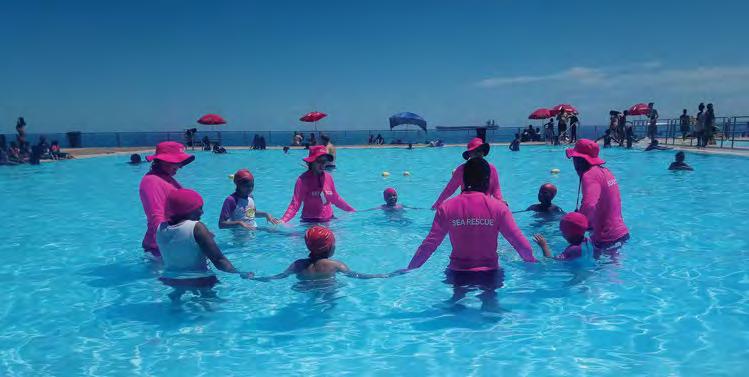
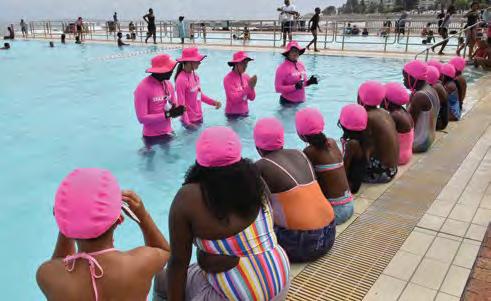
Our Survival swimming programme was piloted in pop up lessons at the municipal swimming pool in Sea Point over the October 2019 school holidays. We up-skilled the swimming ability of 141 children of which 68 were boys and 42 girls, all in the high risk group of 9 to 14 year olds. During that pilot project we included 31 children (in the same age group) who were unable to swim and taught them to be confident in water and to safely swim 25 meters.
The programme will be rolled-out around the country in 2020, taking free swimming lessons to children where they are swimming. The programme is an outcomes-based set of lessons in which children will be able to achieve the various goals at their own pace. Students will be rewarded with a certificate of competence when they have achieved the final goal of being able to get to safety after an unexpected immersion.
ELEARNING PORTAL eLearning is very relevant to our volunteers and Read more about Lawhill Maritime
we are now able to reduce the “in classroom” time by having online modules. This means more time for practical training. We have also made our eLearning Academy available to other organisations, such as Lawhill Maritime Centre, Sea Cadets and St Helena Island Sea Rescue. We currently have approximately 1800 eLearning users. We expanded the list of courses available on this platform and added the following: » P ersonal Survival Techniques » Fire Fighting » Diesel Engineering » Elec tronic Navigation Systems » The Social Literacy Conversation. Centre on page 42.
Bravo Bravo is also one of NSRI’s online learning platforms. The platform is professional with lots of information, without being overwhelming. The first module is the Skippers Guide for small vessels which is a useful course to complete as preparation for the SAMSA skippers’ examinations. In 2019, we completed a written version of this training course – it has the same look and feel as the online version, but it is available in print. In 2020, we plan to update the Bravo Bravo system and add new features to the platform.
In 2019, 1 880 new users registered for Bravo Bravo, and in total there are now 2 293 users registered.
BRAVO, OLIVER! We are a family based in Waterfall just north of Durban. I felt that we should share the following with you.
We home-school our son Oliver, 12 years old. As part of his geography lessons we have given him a project to do: complete the BravoBravo online Skippers Guide for small vessels course.
Oliver is not only enjoying and loving the programme but progressing well. We would love to surprise him with an invite to visit the Durban NSRI station to meet some of the people and to see what great work the NSRI is doing.
Garry Salkow

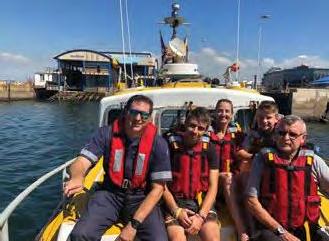

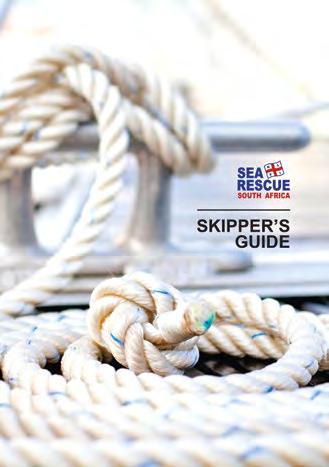
Oliver and his family visited the station on Saturday, 9 March, and after a brief introduction about Sea Rescue, its history and operational capabilities, we launched Eikos Rescuer III. With everyone on board we proceeded to sea where Oliver was shown how a Class 1 rescue vessel is operated and then he was given the opportunity to take the helm. Oliver handled the vessel like a seasoned helmsman, even maintaining a straight course while ‘steering the compass’. Station 5 enjoyed hosting Oliver and his family and have invited them back to visit when the new ORC rescue vessel is on station. (For more information on NSRI’s learning platform BravoBravo, go to bravobravo.co.za)
Primary prevention
The number of rescue operations carried out by the NSRI dropped from 1 138 in 2018 to 757 in 2019, mainly due to preventative measures. Preventative measures can be defined as any actions that provides advice, guidance or direction to a person that mitigates against risk. These include identifying and eliminating hazards, beach or water patrol, moving safe area swimming flags, erecting and moving signage, closing the beach and educating beach goers on fixed hazards. The focus on lifeguarding has changed from being a rescue team on the beach, to being a prevention team whose actions are aimed at eliminating or reducing the severity of incidents and changing the type of rescue service required. The beaches where lifeguards conduct greater amounts of preventative measures, see a lower ratio of rescues.
Proactive drowning prevention education, awareness and physical interventions have also increased dramatically. This leads to fewer rescue operations as members of the public are more mindful about water safety. Sea Rescue launched an intentional campaign in November 2019 with all our media partners to promote safety messages to water users. We can also attribute fewer people visiting the beaches over the festive season due to cooler days and unpleasant weather. This was particularly noticed on traditional beach days such as Boxing Day and New Year’s Day.
Rescue swimming, lifeguarding and safety signs
Sea Rescue’s prevention services department leads our drowning prevention strategy. They are focused on reducing drowning statistics by analysing drowning data to understand who is drowning, where, when and how they drowned and then putting mitigating measures in place to reduce these avoidable deaths. We partner with other organisations that also focus on drowning prevention to achieve our goals and to raise awareness on water safety in South Africa.
To this end, Sea Rescue has worked with several organisations in 2019 to implement the suggestions that came out of the Western Cape Drowning Prevention Framework and the World Health Organisation’s guidelines on drowning prevention.
In 2019, we focused on improving our drowning data collection and capturing, implementing mitigation measures and reporting to targeted audiences of our water safety programme. We piloted and refined our survival swimming courses, streamlined our Pink Rescue Buoy production and distribution methods and produced a surf rescue swimmer manual aimed at our volunteers and municipal lifeguarding projects.
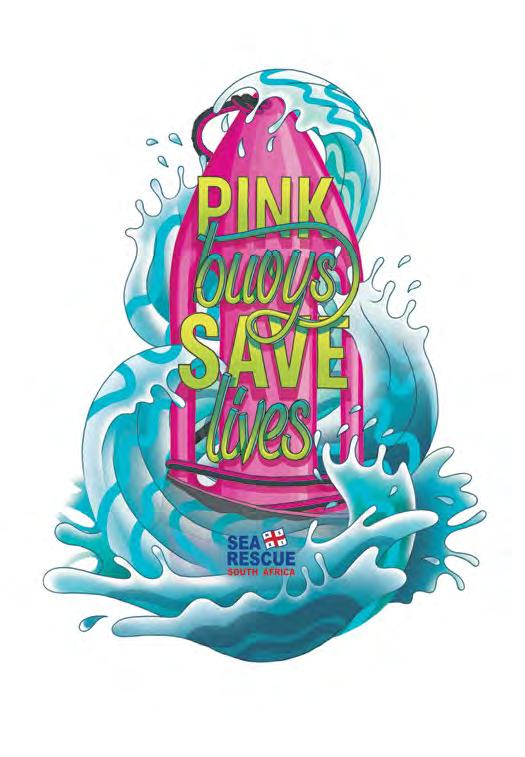
Below is a list of some of the projects we ran in 2019:
PROJECT STATUS Standardisation of emergency signage Ongoing Pink Rescue Buoys Developed and growing – focus is now on inland waters Lifeguarding /rescue swimmer/ beach safety Completed year two – designated swimming areas patrols on the west coast: Lambert’s Bay and are proactively being patrolled and beachgoers are Elands Bay beaches, as well as the Clanwilliam being educated. We are pleased to report that no Dam drownings were reported in these areas and the patrols will be ongoing. Survival swimming programme development Developed and rolling out – ongoing Expansion of lifesaving / rescue swimming Ongoing programme Rolling out of JetRIBs and all-terrain vehicles Ongoing (ATV) for mobile life guarding units
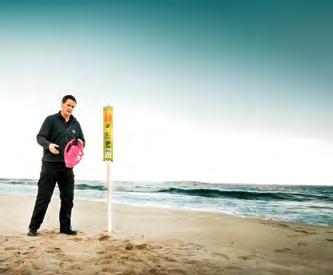
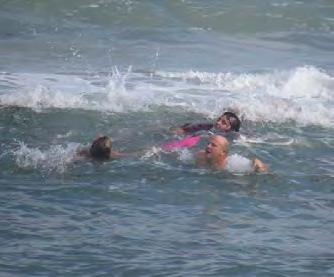

Pink Rescue Buoys
The NSRI Pink Rescue Buoys roll-out started in November 2017, with the first batch erected in the drowning hotspots of Plettenberg Bay and the Wilderness beaches. These buoys form part of our drowning preventative strategy and the idea behind it was to provide emergency flotation for a person in danger of drowning, as well as for a rescuer who decides, against advice, to enter the water to help someone in an emergency.
There has also been notable interest from home owners associations, resort and security estates nationwide for Pink Buoys to be deployed around their pools and dams (e.g. Club Mykonos (10), Springfield Wine Estate (3), Somerset Lakes

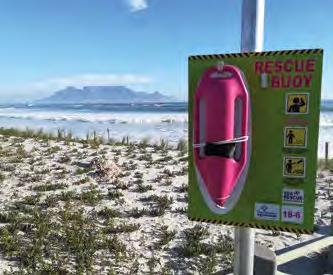
(3), Swadini Resort Hoedspruit (2), Sagewood Estate (1) and Ritsako Game Lodge in Gauteng (1)).
Theft of the buoys was approximately 20% in 2019, with about one in three stolen ones being returned. Our Pink Rescue Buoy mould now has our name and contact telephone number embossed in it, which we trust will result in less buoys being stolen.
As funding becomes available, the areas that we reach with the Pink Rescue Buoys is expanding. All signage installation requires approval from local municipalities and 90% of the signs and buoys are now sponsored by local companies, individuals and municipalities.

We deployed 200 new Pink Buoys in 2019 and currently have a total of 500 active buoys with more being placed every week. 22 people have been assisted using these devices in 2019 – that’s nearly 2 per month, and 57 since the start of the programme in 2017.
Cederberg Municipality water safety project
The Cederberg project started off in September 2018 with the appointment of Nicole Anthoney as a water safety instructor in Lambert’s Bay. In 2019, Nicole taught 29 970 children about water safety.
In late October 2018, the Cederberg Municipality asked if NSRI could facilitate lifeguarding at Lambert’s Bay, Elands Bay and Clanwilliam Dam and, with funding from the municipality and the Western Cape government, we rolled out teams of trained beach patrollers and rescue swimmers at all three venues by 19 November 2018. 2019 was our second year of lifeguarding at these three venues. We are very proud and grateful to be able to report that we had no drownings in this area since the start of the operation. Our management team, including Stewart Seini, Nicole Anthoney and Micheal Beyers, worked very hard to ensure the success of their highly trained rescue swimming teams. The project received widespread acclaim when it was closed on 1 January 2020.
Expanding lifesaving / rescue swimming programme
Lifeguard coordinator, Stewart Seini, has designed a surf rescue swimmer course, which is similar to Lifesaving South Africa’s (LSA) lifeguard award, and we have printed our first 100 manuals. The major difference between our surf rescue swimmer and LSA’s lifeguard award is that we put more emphasis on the use of craft, such as Jet Skis and all-terrain vehicles.
In 2019, we consolidated our lifeguarding operations, which include the Jeffrey’s Bay and Melkbosstrand units. We also have qualified surf rescue swimmers on station at Strandfontein and lifeguards at East London. In the coming year we will work closely with LSA to improve beach safety and expand the network of beaches that are covered by lifeguards and rescue swimmers. A few smaller municipalities have taken note of our achievements on the West Coast and enquired if we can set up professional rescue swimming units on their beaches as well. This is our challenge for 2020 – effective lifeguarding on more beaches and swimming areas through partnerships and exceptional training.
CASE STUDY
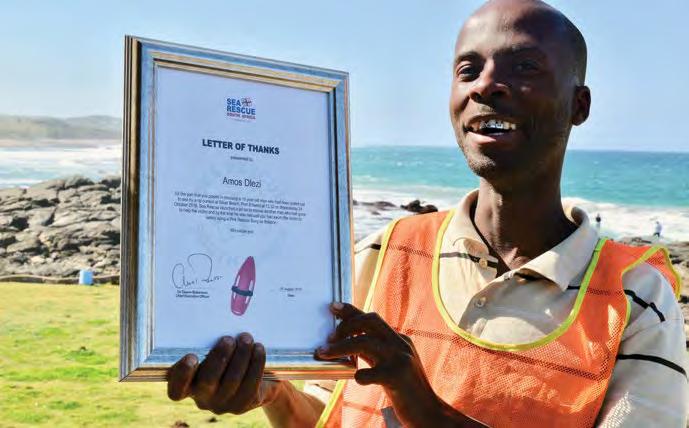
Amos Dlezi, a car guard in Port Edward, Kwa-Zulu Natal, was presented with a Sea Rescue letter of thanks for saving the life of a young man he did not know. He tells the story: “I was sitting and watching cars when guys ran up to me and said two people are caught in the current and in trouble.” He saw the two heads in the water and ran for the Pink Rescue Buoy hanging next to the Sea Rescue base. Using the current, it only took him a few minutes to reach the first man. He said the man was vertical in the water with his head tilted back and water was washing over his face. Amos knew that the man was in danger of drowning and threw the buoy at him. Luckily it landed close to his head and he grabbed it. It took all Amos’ strength to swim the man out of the
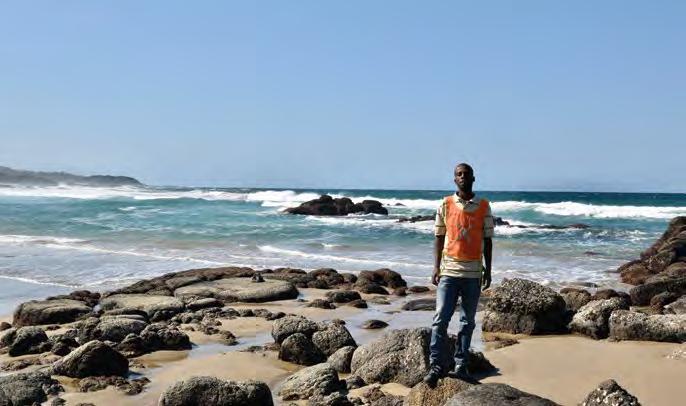
current and back to shore.
Even though he was exhausted at this stage, Amos turned back to help the other man. Fortunately, someone had called the NSRI emergency number in the meantime and Amos looked on as the second man was saved as well. Amos taught himself to swim and surf and this combination of skills taught him to understand the ocean, and more importantly, how rip currents work. This made the difference between life and death for the young man he saved.
We are delighted to report that Amos has subsequently decided to join the Port Edward Rescue base as a volunteer.

Volunteer Crew from NSRI Station 5 Durban
Secondary prevention – rescue
Even with the best preventative measures, there are circumstances when people find themselves in trouble and out of their depth. This is where Sea Rescue comes in – we provide an essential rescue service to South African citizens and foreign nationals, whether they are bathers, sailors, surfers, paddlers, fishers, pilots or SCUBA divers.
The NSRI has always had a core focus on rescuing people when they were out of options to save themselves, and this remains so to this day. The time required to train, prepare, assess, maintain and be on standby for a possible call, 24/7, is substantial, and entirely reliant on dedicated and passionate volunteers around the country. Without them, many people would not have the chance to be rescued, sometimes long after they had given up hope of being saved. Beyond the emotional loss, the economic and social community cost of a life lost, the knock-on impact is massive. In this light, NSRI rescued 949 people over the past year who, if it had not been for the volunteer dedication, would probably not be here today.
NSRI has instituted an Emergency Operations Centre (EOC) which receives emergency calls from a range of emergency numbers. The responsibilities of the EOC are to: » deal with the emergency call flow from public in emergencies » impr ove emergency dispatch systems » enable volunteers to better focus on the rescue tasks at hand » coordinate communications with stations during emergency calls » monitor tracking software and systems, ensuring volunteer safety. The information coming from this unit has resulted in improved rescue efficiencies and a reduction in distracting reporting and administrative processes from front-line operational personnel during rescues.
NSRI is always looking at ways to to increase its service offering and be present in more places (coastal and inland). Doing so requires capacitating more volunteers from all walks of life to be part of the effort, and this is a major strategic focus going forward into 2020 and beyond.
More information about our rescues can be found in the Our Beneficiaries section on page 43.
NUMBER OF PEOPLE RESCUED
1 153
662 728 760
629 1 306
1 224 1 620
949
2010/2011 2011/2012 2013/2014 2014/2015 2015 (9 MONTHS) 2016 2017 2018 2019
CASE STUDY
NSRI ASSIST THE EMERGENCY SERVICES DURING FLOODS IN KWA-ZULU NATAL
On Monday 22 April 2019, NSRI Durban and NSRI Ballito assisted the emergency services with flood related incidents in the greater Durban area. The incidents included rescuing trapped residents, evacuating flooded structures, vehicle entrapments and persons, animals and vehicles being swept away by floods or trapped by swollen rivers.
A number of emergency services were deployed in the area, such as the Police, Police Search and Rescue, IPSS medical and rescue, eThekwini lifeguards, eThekwini Fire and Rescue Services, KZN Government Health EMS, Disaster Risk Management, Netcare 911 ambulance services, ER24 ambulance services, and additional local private ambulance services and security companies.
On Tuesday 23 April, NSRI Shelly Beach, NSRI Port Edward and NSRI Rocky Bay were called out to assist the emergency services with flood related incidents on the South Coast.
While multiple incidents were attended to by the emergency services, the NSRI attended to 31 incidents with Police Search and Rescue and affiliated services. These incidents ranged from structural collapses, drowning incidents, mudslides, entrapments, evacuations and animal rescues.
NSRI commends all the services that came

together in this trying time for community services and the communities of Kwa-Zulu Natal during these floods.










